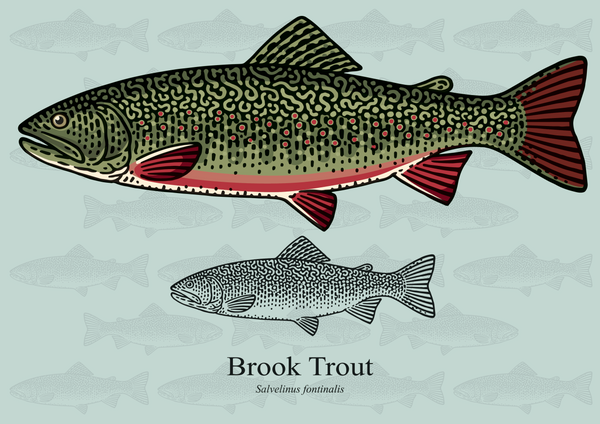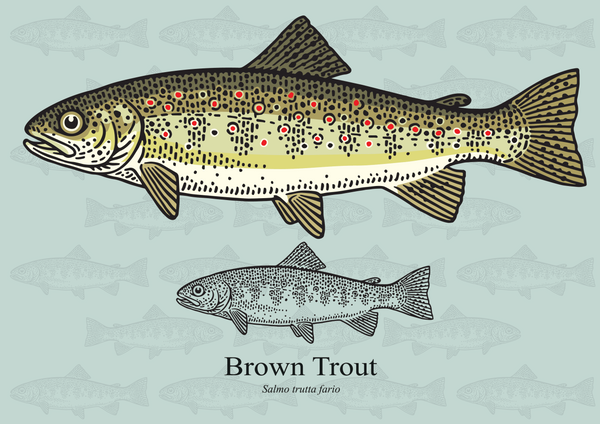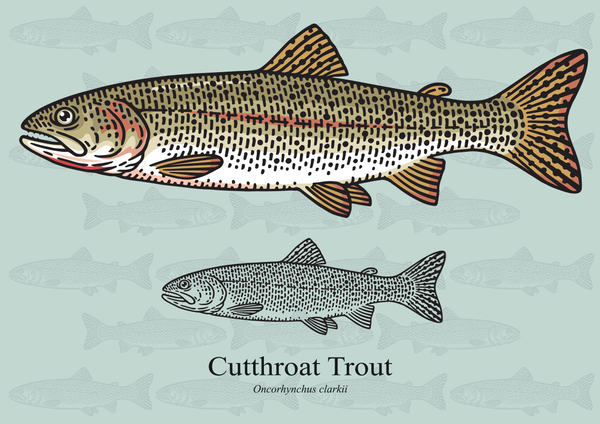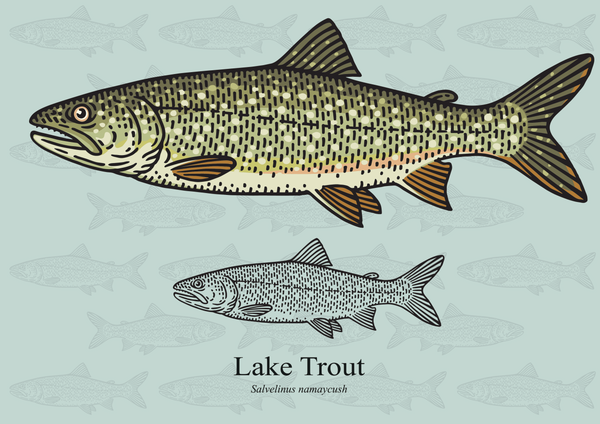BACK
Fish Facts: A Guide to Trout
By: Acme Smoked Fish

Since we’ve covered the most popular salmon species, we will continue our raw material guide series with a discussion of some of the most well-known trout species!
Steelhead Trout (or Ocean Trout)
We’ll start off our discussion with a fish that we touched on in our last guide, steelhead trout. You may be wondering, what is steelhead then? Is it a salmon or a trout? Steelhead is actually a trout, even though it is quite often referred to as salmon. Steelhead trout is frequently classified as salmon due to its size, appearance, and the fact that this species can spend a large portion of their life cycle in the ocean. However, steelhead (or ocean trout) is essentially a rainbow trout that is anadromous, meaning that it spends portions of its life cycle in saltwater. Steelhead are smaller than most salmon species, reaching about 20-25 inches in length. That is well below the mature size of most salmon species but places this fish among the larger of the trout varieties.
Steelhead can reach a weight of roughly 20 pounds at their largest, but they typically fall closer to the 2-8 pound range on average. While true salmon are saltwater fish that swim into freshwater to reproduce at the end of their lifecycle, steelhead often move between both at various stages of their development. And while like salmon they swim upstream in freshwater environments to reproduce, they come back to the ocean and often have multiple spawning cycles in their lifespan.
In terms of flavor, steelhead tends to have a lower natural fat content than certain varieties of salmon such as Atlantic and King. That said, as most commercially available steelhead are farm raised (like Atlantic salmon) the fat content can be similar when found in stores. Steelhead trout tends to have a lighter, milder flavor than many salmon varieties, but only slightly. This makes steelhead trout easy to use in a variety of dishes, much like salmon. If you are looking for a salmon-like fish with a mild, yet distinct flavor, steelhead trout is a great choice. Steelhead is easy to integrate into a variety of fun and easy dishes like tacos, soups, or salads!
Rainbow Trout

Next up, let’s discuss rainbow trout! This is the species that we at Acme Smoked Fish use in our trout products. While rainbow trout and steelhead trout are technically the same species, the distinction between rainbow trout and steelhead trout is in their life cycle. Steelheads typically spend the first year or two of their lives in freshwater, and then spend most of their remaining lifespan in saltwater, often only returning to freshwater to reproduce. Although steelhead trout are capable of living their entire lifecycle in freshwater, this would then make them rainbow trout, as rainbow trout are a purely freshwater fish with no actual taxonomic distinction from steelhead trout. The rainbow trout is native to cold water tributaries throughout Asia and North America.
Like the Steelhead Trout, Rainbow Trout is known for its mild taste and delicate texture. It’s often described as being slightly nutty in flavor, with white, pink, or orange filets depending on the fish's diet. While most rainbow trout biomasses living in tributary environments typically reach about 1-5 pounds in size, other rainbow trout populations in lake environments (like the U.S. Great Lakes) have been known to reach 20 pounds! Rainbow trout (so, steelhead trout as well) are part of the genus Oncorhynchus, which puts them in the same genus as several Pacific salmon species.
Brook Trout

Brook trout has a slightly sweet flavor similar to salmon, and a light and delicate meat like rainbow trout. Technically, the brook trout is considered a char from the genus Salvelinus, whereas certain other trout species are in the Salmo genus, and more taxonomically similar to Atlantic salmon. Perhaps the most obvious distinguishing physical feature of the brook trout is the heavy patterning on its back, which tends to look like vermiculation. This, along with a skin coloration that can range from a light silvery blue to dark green, is often cited as identifying characteristics for the species. They can also sport light spots of red, yellow, or off-white in various shades.
Brook trout spawn in the fall, and their original native range extended from the inland coastal waters of Northeastern North America westward to Manitoba and the Great Lakes. Like rainbow trout, brook trout have seen their historical range extended through introduction. Brook trout are now found in Western North America, South America, Europe, Asia, Africa, and New Zealand, among other localities.
Sea-run brook trout are brook trout that live part or most of their life cycle in saltwater environments, such as Hudson Bay. In this way sea-run brook trout are to brook trout what steelhead trout are to rainbow trout. Brook trout are not specialized to favor a particular environment within their range, as they are found in shallow streams as well as deep lakes and in the ocean as well. In large lakes, brook trout can reach over 2 feet in length and weigh up to 15 pounds. Sizes are more modest in river and stream environments where they tend to only reach 6-15 inches and weigh 1-5 pounds.
Brown Trout

Brown trout stand out on this list in that they are not a trout species native to North America but are actually endemic to Europe and Asia. They are believed to have been introduced to freshwater lakes in Michigan in 1883. Now, like rainbow trout, brown trout have been observed in every continent, besides Antarctica. That said, they tend to have a higher tolerance for warm water than both rainbow and brook trout, so their range is a bit broader across the globe.
Brown trout are a popular sport fish and tend to reach a similar average size to that of the brook trout, though with rare yet exceptional examples reaching sizes in excess of 3 feet in length. Sport fishermen are well known to eat this catch, but it is often considered a bit gamier and less prized as a food fish than rainbow, steelhead, or brook trout.
In terms of appearance, brown trout are typically a shade of brown on their back and sides, with this color fading to a yellow or cream-colored belly underneath. Brown trout tend to spawn in the fall, but certain populations have been noted to spawn as late as mid-winter. The brown trout is in the genus Salmo, making it more closely related to salmon than the brook trout. We at Acme Smoked Fish have no plans to start smoking Brown Trout in the near future, but if any of you anglers out there catch and smoke one, drop us a line and let us know how it tastes!
Cutthroat Trout

Cutthroat Trout occupies a large range throughout the western regions of North America, with a native distribution from the Prince William Sound of Alaska to California’s Eel River. This range extends into the inland waterways of the Great Basin and the drainages of the South Saskatchewan, Upper Colorado, Platte, and Arkansas Rivers. Like the rainbow trout, the cutthroat trout belongs to the genus Oncorhynchus, making it similarly related to various Pacific salmon species. Cutthroat and rainbow trout populations are frequently observed to cohabitate in similar areas, and oftentimes hybridization occurs, although they are still considered distinct species. Cutthroat trout typically breed in February and March among their more coastal populations. More inland populations tend to breed in April and May.
Cutthroat trout is often described as having a similar taste to that of rainbow trout, but slightly stronger in flavor. Many anglers who keep their catch enjoy them and consider them an equal culinary prize to that of the more popular rainbow trout. Similar to rainbow and steelhead trout, cutthroat trout has a distinct and significant sea-run subspecies. Often called “coastal cutthroats”, the sea-run variety is characterized by a profusion of small spots, whereas the inland (or “interior cutthroat”) subspecies tends to have fewer and larger spots. However the identifying characteristics of cutthroat trout tend to be less distinct and more varied, so scientists tend to use biological testing methods to identify the species, when in question.
Lake Trout

For a time, lake trout was considered a part of the no longer recognized genus Cristivomer but has since been reclassified as a part of the Salvelinus genus, which includes various other trout species as well as char. Lake trout are often found in deep, cold lakes, but can often be found in the rivers entering or exiting such lakes. Their native range is from Alaska and British Columbia eastward to Labrador and New England, and stretches as far south as the Great Lakes, the headwaters of the Mississippi River, and the Missouri River drainages.
Lake trout tend to be less colorful than other species of salmonid. Their principal coloration can range from shades of gray to olive-green, and their bodies are densely covered in pale spots. Unlike many other species of salmonid, the lake trout’s coloration does not change significantly during its spawning season.
Lake trout can grow quite large for trout species, with many mature adults reaching lengths in excess of 3 feet, with the longest on record at 50 inches. 40-pound examples of lake trout are not uncommon, with the largest recorded weighing in at 102 pounds. These large specimens of lake trout are prized as sport fish but are not highly regarded as food fish. Many anglers choosing to eat this catch find the meat greasy and fatty. You won’t find this species in Acme smokers any time soon, but as always, if you get a chance to try smoked lake trout, please let us know what you think!
Bull Trout
Like the lake trout, bull trout is in the Salvelinus genus, making it related to many salmonid species likewise classified among the chars. Also like the lake trout, bull trout is another of the larger trout species, albeit not quite as large as the lake trout. Adult bull trout are about 25 inches on average with the largest recorded length being 40.5 inches for a specimen that weighed over 30 pounds.
The bull trout is distributed throughout North America in an inland north-south belt stretching along the waters that run off of the Rocky Mountain and Cascade Mountain Ranges from the Southern Yukon to the northern edges of California and Nevada. Bull trout are non-anadromous, meaning that they spend their entire lives in freshwater without any phase of migration to saltwater, feeding, spawning, and migrating entirely in freshwater environments.
Bull trout get their name from their main distinguishing feature, their head, which is uncommonly longer, broader, and flatter than other species of trout within the same habitats. Bull trout are another popular sport fish, and to those who enjoy eating them, they are described as mildly oily, but with a pleasant flavor somewhere between that of the lake trout and cutthroat trout. We have a few recreational anglers in the Acme family, but when it comes to bull trout, it’s always catch and release for us, because this species is considered “Vulnerable” by the International Union for Conservation of Nature.
Going to the store for smoked trout? Choose Acme Smoked Fish!
Although we don’t smoke all of these trout varieties at Acme Smoked Fish, we do make some of the most delicious smoked trout around! Our team at Acme Smoked Fish is always busy finding new ways to bring smoked fish products, like our smoked trout, to a store near you. Check out our Store Locator to find out where to buy Acme products in your local market or contact us and we would be more than happy to help in your search for delicious smoked trout, smoked salmon, and other specialty smoked fish products. If you are local to Brooklyn, come by our Fish Friday retail experience and check us out and say “Hello”. Wherever you are, we look forward to assisting you with all of your smoked fish, smoked trout, and smoked salmon needs!